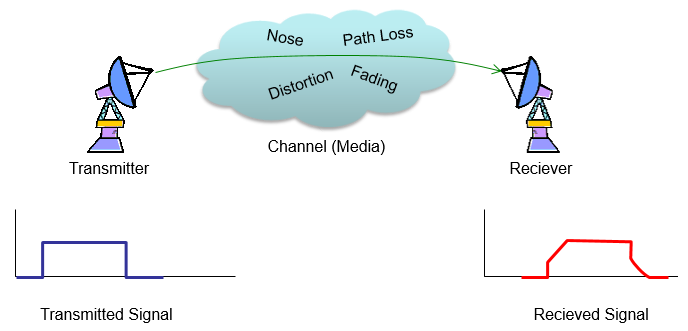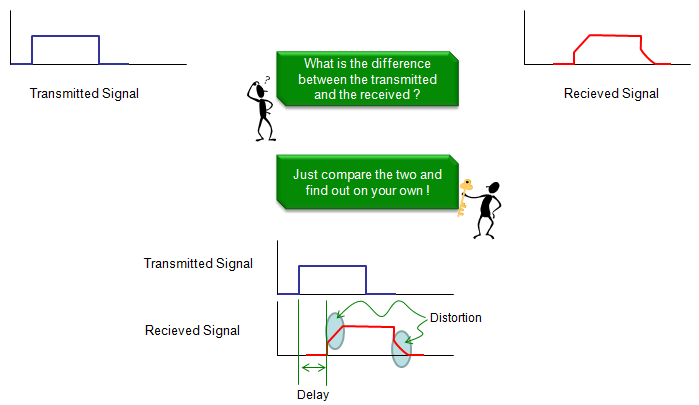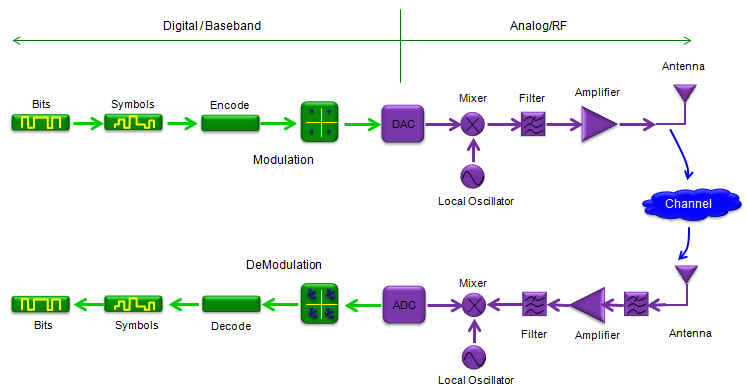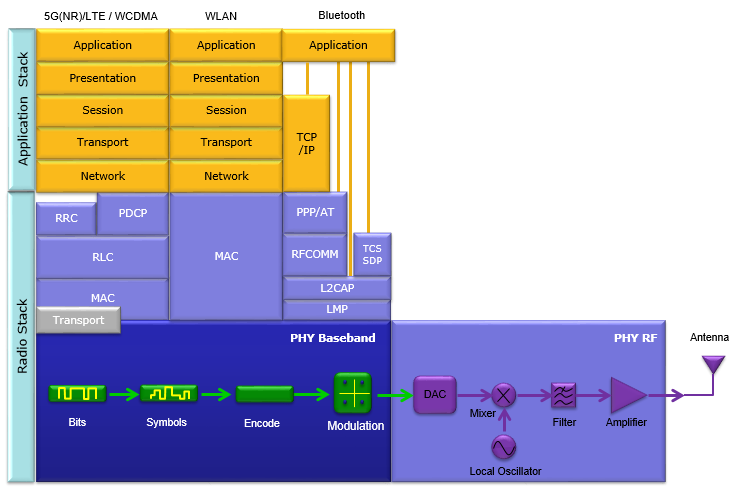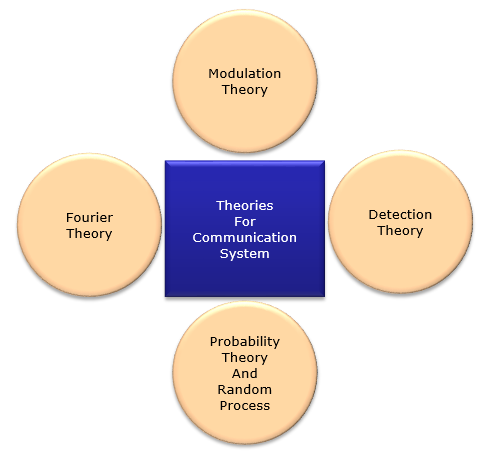|
Communication Technology |
||
|
What is Communication ?
Communication Technology is a special technique to send data from one place to another. A typical concept can be illustrated as follows. As you see, there are at least three major components getting involved in any kind of communication process, a sender (transmitter) and reciever and the channel. You would intuitively know what is transmitter and reciever.
Since this is an introductary pages for communication system, I will touch with some some high level topics about communication system in this page. Followings are the list of topics that will be dealt with in this page.
Channel is a physical media through which the transmitted signal follow. For example, in a very simple communication system like RS232. What you call RS232 cable (made up of copper) is the channel. Let's think about ethernet communication (wired LAN). In this case, what you call LAN cable is the channel (one PC can be an transmitter and another PC can be a reciever.). How about mobile communication like a mobile phone ? My mobile phone and a basestation can be a transmitter and reciever and the air space and all other obstacles(e.g, mountain, building etc) in between a mobile phone and a base station can be a channel. In short, a signal (data) from a transmitter always go through a specific channel to reach the reciever. Studying the communication system means understanding the characteristics of those three major components, Transmitter, Channel, Reciever.
Now let's loot at the illustration shown above and assume that a transmitter sent a signal as shown in the left bottom (in blue) the signal detected by the reciever is shown in the right side (in red). What is the first thing you noticed in the illustration ? It would be that the transmitted signal and the received signal is not exactly same.
What is the difference ? Let's look at following illustration. The difference in this specific example is as follows.
Now you would ask why we have this kind of differences ? Intuitively you may think of several possible reasons as follows. i) Transmitter didn't send clear signal. (It was supposed to send the exactly same shaped as shown in the illustration, but it failed to send such a clean signal). ii) Reciever didn't detect the signal very well. iii) The signal was changed (distorted) while it follow through the channel. Any of these problem can happen. Actually in most cases, all of these problem happens simulteneously. The purpose of studying communication technology is to find techniques to reduce these problems as much as possible and find out proper answers to following questions. i) How can I design a transmitter that can transmitter a signal exactly as I intended ? ii) How can I reduce the influence of the distortion (and noise) created by the channel ? iii) How can I design a reciever that can accurately detect the signal as I intended ? You may just recall all those mathematical equations and techniques like transfer functions, convolution, deconvolution, impulse response, filter, fading etc from text books and have no idea on why we need those things and how those things gives you the answers to the fundamental questions listed above ?
What would be the most difficult question among them ? I think it is question ii) and very large portions of theories and techniques that we learn from the text book is mainly to find the answers to the question ii). In other words, if we can find and use as we like a medium(channel) which does not distort the signal going through it, most of communication text book can be written in much simpler way.
Overall Architecture of Communication System
Following is an example of a typical communication system. More specifically, it is a typical structure of wireless communication. Usually, the parts illustrated in green can be seen both in wireless and wired communication, but the parts illustrated in violet would be seen in wireless communication. What you usually see in digital communication text book or signal processing books are related to the parts in green. What you see in RF text book are related to the parts in violet. I would not exaplain each of these components in detail here. The purpose of putting this illustration in this page is just to give you a big picture of a whole communication system.
For the details of the parts illustrated in green, refer to 'Communication Technology' and Signal Processing and Communication page in Matlab/Octave pages. For the parts in violet, I would try posting other separate pages in the future. For now, just try to follow through each components and make a story on your own based on your common sense.
Actually the system structure of a communication system show above is only for one portion (physical layer) of the system. Only very simple communication system can be built from this structure only. In most of the communication system you are using in daily life has much more complicated structure. In most communication system, a lot of other complicated layers are sitting on top of the physical layer as illustrated below. Each of the blocks in this illustration requires a huge number of engineers for research, development and testing and this full structure forms a huge industry.
Challenges in Communication / Critical Factors in Communication System Design
In most of the communications, you would face several major challenges you (or the industry) need to handle as listed below. As you study communication technologies, you would notice that there are a lot more things to study than you might have imagined at the beginning. Huge portions of those details are required to handle these challenges.
When you study the topics in communication technology, just asking yourself a question as follows and finding the rough answer can be an excellent starter for you. The question is 'Is this topic (techniqu) for increasing speed or increasing reliability or media sharing or Scalability related ?;
To study in almost any engineering field, the biggest question would be 'do I need to learn theory first ?' or 'do I need to jump into an applications and have some hands-on experience first ?'. As you may guess, there wouldn't be any firm and clear answer for this. In whichever way you go first(theory first or hands-on first), you would feel something missing because of the way you haven't gone through.
If you go with theory first (like starting the area in University), you would think 'why do I need to learn all these strange things ?', 'what does this mean in practical sense ?'. 'Would this really help anything in daily engineering job ?'. Without any clear answer to these questions, it would be very challenging to keep you motivated (or even being awake) to stick to those theories (textbooks). Without practical experience, it would be difficult for you to find answers to these questions.
If you go with hands-on (experience) first (like staring the carrier path that is different from your university background), you may come across many situations where 'I know this is working, but why this is working ? how this work as I see now ?'. Why they (the industry) came out with such a strange looking algorithms and equations in the technical specification ?'. To find the answer to these questions, you would need some study on theoretical background of the area in which you are working.
Studying (or working ) in the field of communication, what kind of theory you need to study ? Following illustration shows some theories you wound need in this area. This list is from Ref [2] and after spending over 10 years in wireless communication technology and as a person who has been working in a completely different area from University background, I agree with this suggested list. If you are working in electronic/electrical engineering based communication technology (usually physical layer or lower layer), you might already have some familiarity on Modulation / Fourier Theory. If you are working in computer engineering based communication, you might be more familiar with Detection Theory. But whatever you started first, I think you need to be familiar with all of these theories eventually. Personally I am still struggling a lot with Probability Theory/Random Process and have difficulties in associating these theory with the area I am working.
Refernece :
[1] MIT OPENCOURSEWARE : Introduction to EECS II: Digital Communication Systems [2] Introduction to Analog & Digital Communications by SIMON HAYKIN, MICHAEL MOHER
|
||

